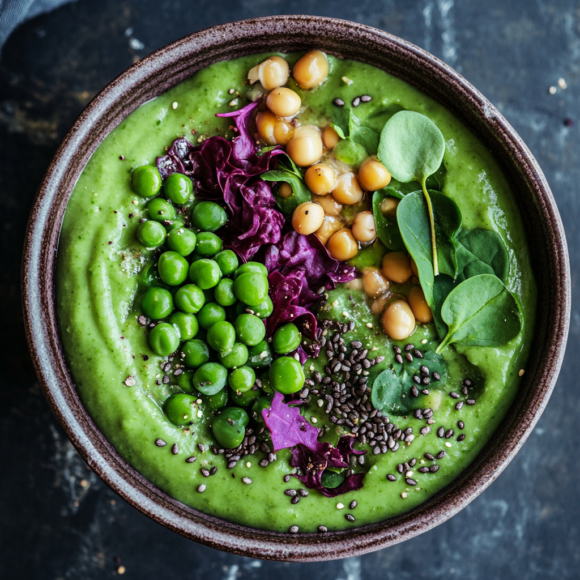What Is Pea Protein and Why Should You Use It?
Pea protein is a plant-based protein derived from yellow peas, known for its high nutritional content and versatility. It’s an excellent source of essential amino acids, making it an ideal choice for those seeking a plant-based protein alternative. Packed with fiber, vitamins, and minerals, pea protein supports muscle repair and overall health. Unlike some other protein sources, it is hypoallergenic and easily digestible.
One of the main reasons to consider pea protein recipes is their adaptability in different cuisines. Whether you’re looking to add protein to smoothies, baked goods, or savory meals, pea protein blends effortlessly. Additionally, its neutral flavor guarntees it complements rather than overpowers the taste of your dishes. For vegans, vegetarians, or anyone avoiding animal-based proteins, pea protein is a reliable and nutrient-dense alternative that supports diverse dietary needs.
The Benefits of Cooking with Pea Protein
Cooking with pea protein offers numerous health benefits, making it a smart addition to your diet. One key advantage is its high protein content, which supports muscle growth and repair. This makes it particularly beneficial for athletes, fitness enthusiasts, and individuals looking to boost their protein intake. Additionally, it promotes satiety, which can help with weight management.
Another benefit of incorporating pea protein recipes is its low allergenicity. Unlike whey or soy, pea protein is free from common allergens, making it suitable for those with dietary restrictions. It’s also rich in iron and contains no cholesterol, supporting heart health. Furthermore, its versatility allows you to create both savory and sweet dishes. From protein-packed pancakes to hearty soups, pea protein improves your meals without sacrificing flavor or nutrition.
How to Incorporate Pea Protein into Your Daily Diet
Adding pea protein recipes to your routine is simple and convenient. Begin by identifying meals where you can easily include a scoop of pea protein powder. Breakfast options, such as smoothies or oatmeal, are an effortless starting point.
For lunch, consider mixing pea protein into soups, stews, or even salad dressings. It’s a great way to enrich your meals with protein without altering their taste significantly. For dinner, blend it into sauces or use it as a flour alternative in recipes like veggie patties.
Other ideas include:
- Adding pea protein to homemade energy bars.
- Stirring it into yogurt or dairy-free alternatives.
- Using it in baked goods like muffins or bread.
Experimenting with pea protein recipes guarantees that you reap its benefits while keeping your meals exciting and flavorful.
Ingredients of Pea Protein Recipes
Creating pea protein recipes begins with selecting the right ingredients. The main component, of course, is high-quality pea protein powder. Look for unsweetened and unflavored varieties to maximize versatility. Other essential ingredients vary based on the recipe but often include:

Fruits and vegetables for added nutrients and flavor.
Dairy or plant-based milk for smoothies and baked goods.
Whole grains, such as oats or quinoa, for balanced meals.
Healthy fats, including nuts, seeds, or oils.
Natural sweeteners like maple syrup or honey.
By combining these ingredients creatively, you can craft wholesome dishes that cater to your nutritional needs and taste preferences.
Savory Pea Protein Recipes You’ll Love
Savory pea protein recipes provide a satisfying way to enjoy hearty, nutrient-dense meals. These dishes are perfect for lunch or dinner and guarantees you meet your protein goals without relying on animal products.
Popular options include:
- Protein-packed veggie burgers: Mix pea protein powder with black beans, spices, and breadcrumbs to create flavorful patties.
- Creamy soups: Blend pea protein into roasted vegetable soups for an extra protein boost.
- Protein-enriched pasta sauces: Add a scoop to marinara or Alfredo sauces for a creamy and satisfying texture.
Savory recipes showcase the versatility of pea protein while keeping your meals delicious and filling.
Delicious Smoothies with Pea Protein
Smoothies are one of the easiest ways to incorporate pea protein recipes into your daily diet. With their customizable nature, you can blend your favorite ingredients into a nutrient-rich beverage perfect for any time of day.
Start with a base of milk or a plant-based alternative. Add fruits like bananas, berries, or mangoes for natural sweetness. Incorporate vegetables like spinach or kale for added nutrients. Include a scoop of pea protein powder, and don’t forget healthy fats, such as nut butter or chia seeds.

Here’s a simple recipe:
1 cup almond milk
1 frozen banana
1/2 cup mixed berries
1 handful spinach
1 scoop pea protein powder
Blend everything until smooth for a refreshing, protein-rich treat that’s both healthy and satisfying.
Pea Protein in Baked Goods: Sweet and Healthy Treats
Pea protein recipes shine in baked goods, offering a nutritious twist on classic treats. Adding pea protein powder to muffins, cookies, or pancakes not only increases their protein content but also helps create a balanced snack or breakfast option.
When baking with pea protein, remember to adjust the liquid ratios in your recipe to avoid dryness. Popular ideas include:
- Chocolate protein brownies: Replace a portion of the flour with pea protein powder.
- Protein muffins: Combine pea protein with oats, mashed bananas, and nuts.
- Pancakes: Use pea protein in the batter for fluffy, nutrient-packed pancakes.
These baked goods are perfect for meal prepping and make healthy eating enjoyable and convenient.
Quick and Easy Snacks Using Pea Protein
Snacks are an essential part of any diet, and pea protein recipes make it simple to create healthy, high-protein options. Quick ideas include energy balls made with oats, nut butter, and pea protein powder. Simply mix the ingredients, roll into bite-sized pieces, and refrigerate.
You can also create protein-packed dips, such as hummus enriched with pea protein. Pair it with fresh vegetables or whole-grain crackers for a satisfying snack. For those with a sweet tooth, try blending pea protein into yogurt with some honey and granola.
These easy-to-make snacks are not only delicious but also keep you feeling refreshed throughout the day.
Step-by-Step Guide to Making Pea Protein Recipes
Making pea protein recipes involves simple steps that anyone can follow. First, choose a recipe that aligns with your preferences and dietary needs. Next, gather your ingredients, including pea protein powder and complementary items like fruits, vegetables, or grains.

Follow these steps:
Cook or bake as required, ensuring you follow the recommended temperatures and times.
Start with wet ingredients, such as milk or water, and blend them with pea protein powder.
Add other ingredients, ensuring everything is evenly mixed.
By following these steps, you’ll create delicious and nutritious dishes every time.
How to Make Pea Protein Powder at Home
Making your own pea protein powder is a cost-effective and rewarding process. Start by purchasing dried yellow peas and grinding them into a fine flour using a high-powered blender or food processor.
Next, separate the protein from the starch using water and a filtration method, such as fine cheesecloth. Dry the resulting protein-rich paste in a dehydrator or low-temperature oven, then grind it again into a fine powder.
Homemade pea protein allows you to control the quality and purity of your protein source. Store it in an airtight container to maintain freshness and use it in all your favorite recipes.
Pea Protein for Vegans and Vegetarians
For vegans and vegetarians, pea protein recipes are a game-changer. They provide a complete protein source, fulfilling amino acid requirements typically met by animal products. From smoothies to baked goods, pea protein guarantees variety and nutrition in plant-based diets.
Additionally, it pairs well with other plant-based proteins like quinoa or lentils, creating balanced meals. Its accessibility and versatility make it a staple for those committed to a cruelty-free lifestyle.
Pea Protein for Weight Loss and Fitness Goals
Incorporating pea protein recipes into your diet supports weight loss and fitness objectives. It promotes fullness, reducing the urge to snack on unhealthy options. Additionally, its high protein content helps preserve muscle mass during weight loss.
For fitness enthusiasts, pea protein aids muscle recovery and growth after workouts. Whether used in pre-workout snacks or post-workout shakes, it offers a convenient way to meet nutritional needs.
Addressing Common Myths About Pea Protein
Despite its benefits, pea protein is often misunderstood. Some believe it lacks essential amino acids, but it is a complete protein. Others assume it has a strong taste, yet high-quality powders are virtually flavorless.
Clarifying these misconceptions helps more people embrace the versatility and health benefits of pea protein recipes.
Frequently Asked Questions About Pea Protein Recipes
What is the best way to use pea protein?
Pea protein is versatile and easy to use! The best way depends on your goals and preferences:
- Smoothies: Blend it with fruits, vegetables, and a liquid like almond milk or water for a nutritious shake. Adding flavors like peanut butter, cocoa, or vanilla extract can mask any natural earthy taste.
- Baking: Use it to boost the protein content in pancakes, muffins, or energy bars. Replace a small portion of flour with pea protein in recipes.
- Soups or stews: Stir it into soups or stews for added thickness and protein without altering the flavor much.
- Post-workout shakes: Combine it with fast-digesting carbs like a banana for optimal recovery after exercise.
What mixes well with pea protein?
Pea protein pairs well with a variety of ingredients to improve flavor and texture:
- Liquids: Almond milk, oat milk, coconut milk, or water.
- Fruits: Bananas, berries, mango, or pineapple add natural sweetness and mask the earthy taste.
- Nut Butters: Peanut butter, almond butter, or sunflower butter add creaminess and richness.
- Sweeteners: Honey, maple syrup, or dates can balance the flavor.
- Spices/Flavors: Vanilla extract, cinnamon, cocoa powder, or matcha.
- Vegetables: Spinach, kale, or zucchini blend well in smoothies for a hidden veggie boost.
Why is pea protein so gross?
Some people find pea protein “gross” because of its natural earthy flavor or gritty texture. However, this can usually be fixed:
- Flavor Options: Opt for flavored varieties (e.g., chocolate or vanilla) to reduce the earthiness.
- Blending: Use a high-speed blender to guarantee a smooth consistency, especially when adding fruits and liquids.
- Mixing Ratios: Start with a smaller amount and gradually increase to get accustomed to the taste.
- Brands Matter: Some brands taste better due to improved formulations—experiment to find one you like.
Is it good to drink pea protein every day?
Yes, it can be good to drink pea protein daily, as long as it fits your dietary needs and lifestyle:
- Health Benefits: Pea protein is a high-quality plant-based protein with all nine essential amino acids. It’s rich in iron, allergen-friendly, and supports muscle recovery.
- Balanced Diet: It’s best to consume pea protein as part of a balanced diet. Pair it with whole foods like fruits, vegetables, grains, and healthy fats to guarantee you’re meeting your overall nutritional requirements.
- Digestive Health: If you experience bloating or discomfort, monitor your intake and drink plenty of water. Gradually introduce it if you’re new to protein supplements.
With the right preparation, pea protein can be a delicious, convenient, and healthy part of your routine!
Conclusion
Incorporating pea protein recipes into your diet is a practical and delicious way to boost your nutrition. Whether you’re looking to improve your fitness, support weight loss, or enjoy plant-based meals, pea protein offers endless possibilities. Start experimenting with these recipes today for a healthier, more balanced lifestyle.
Looking for inspiration ? try more healthy and flavorful recipes to spice up your cooking routine!
Healthy Blackstone Recipes: 10 Delicious and Easy Dishes to Try
Nutrient-Packed Quinoa Beet Salad: A Healthy and Delicious Choice
Yogurt Covered Fruit Snacks: A Nutritious and Delicious Treat


3 thoughts on “15 Easy Pea Protein Recipes for a Healthy and Balanced Diet”